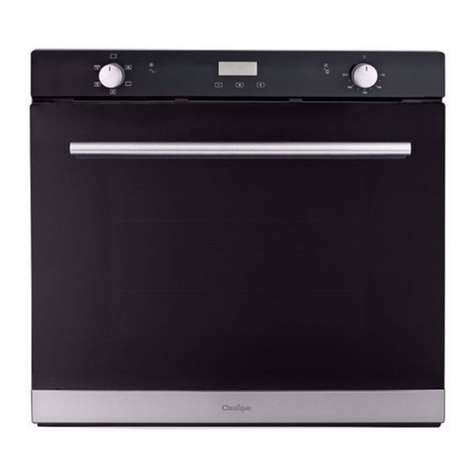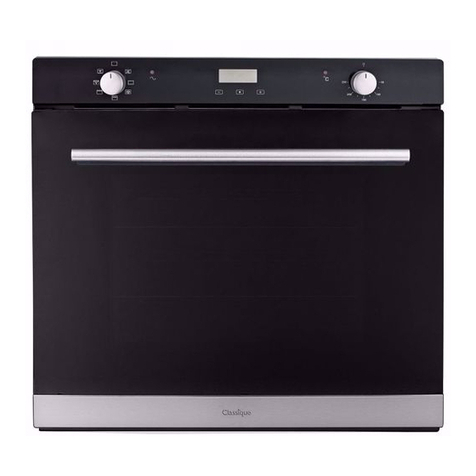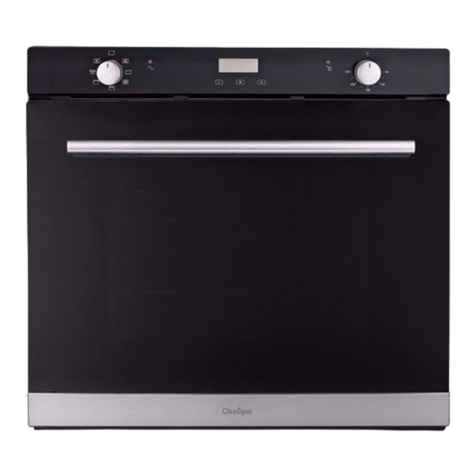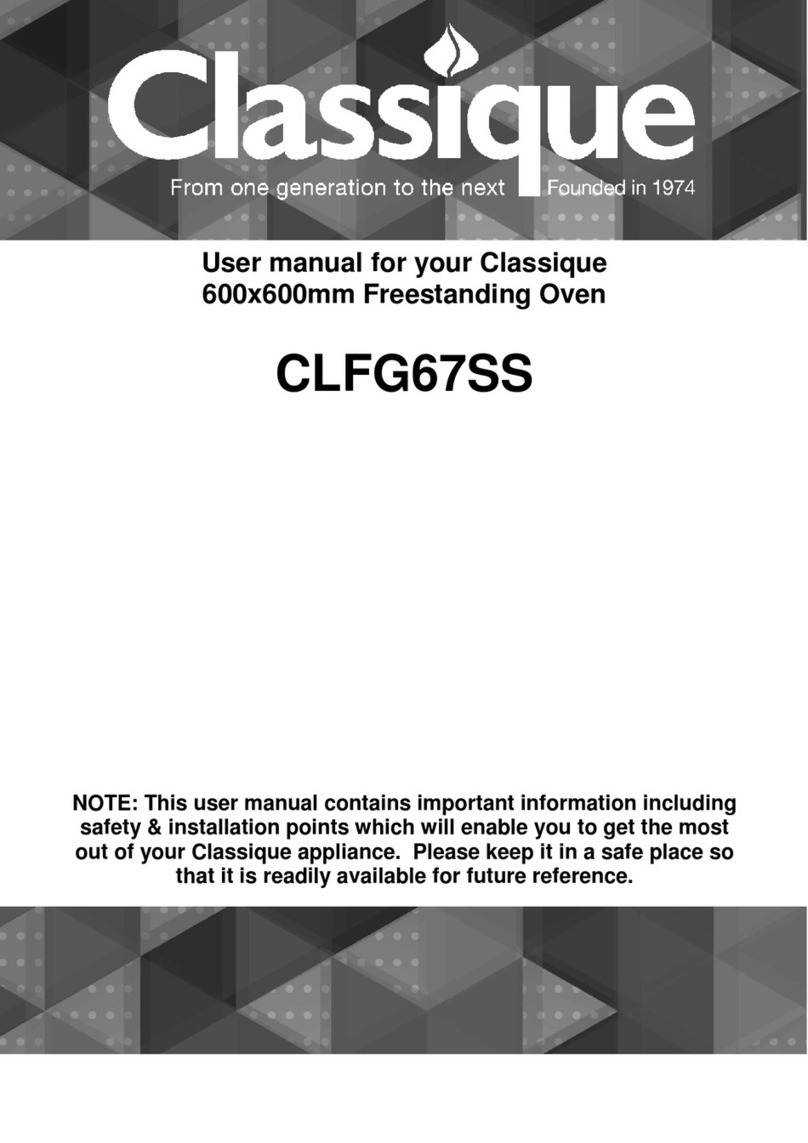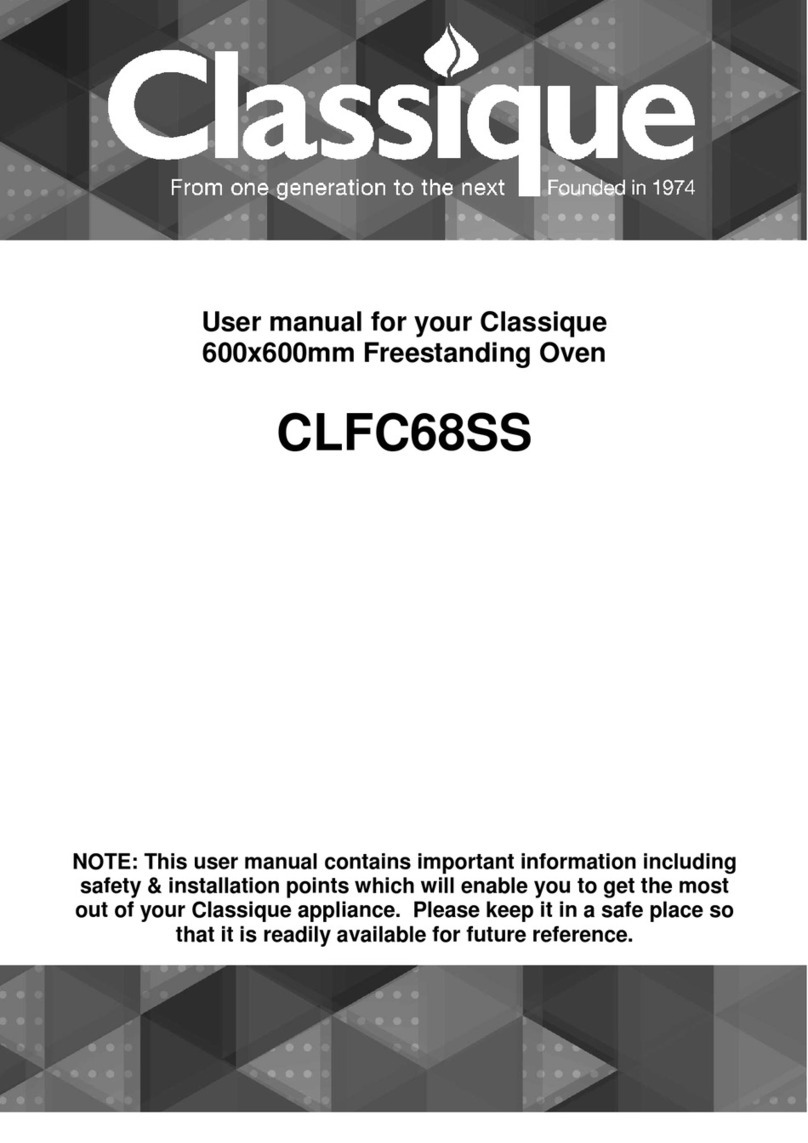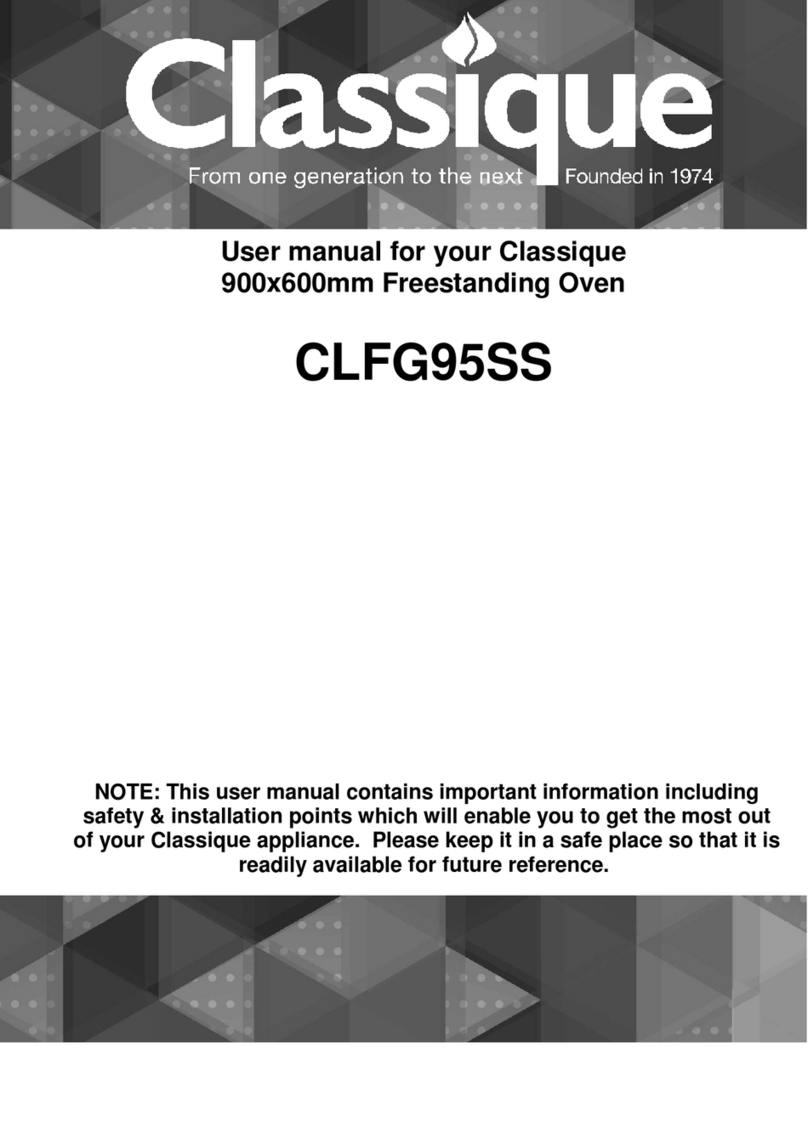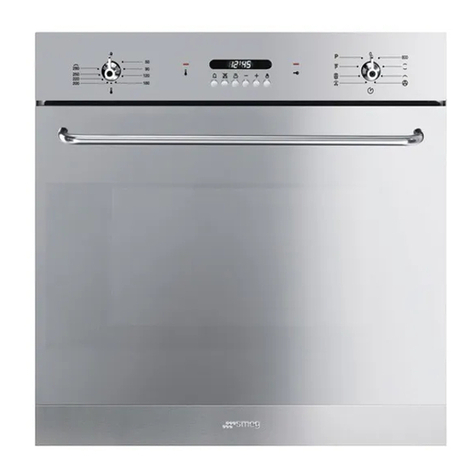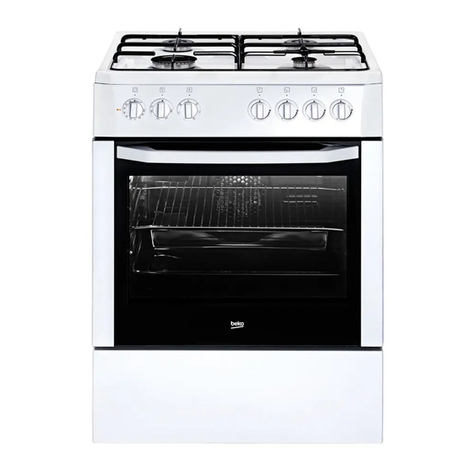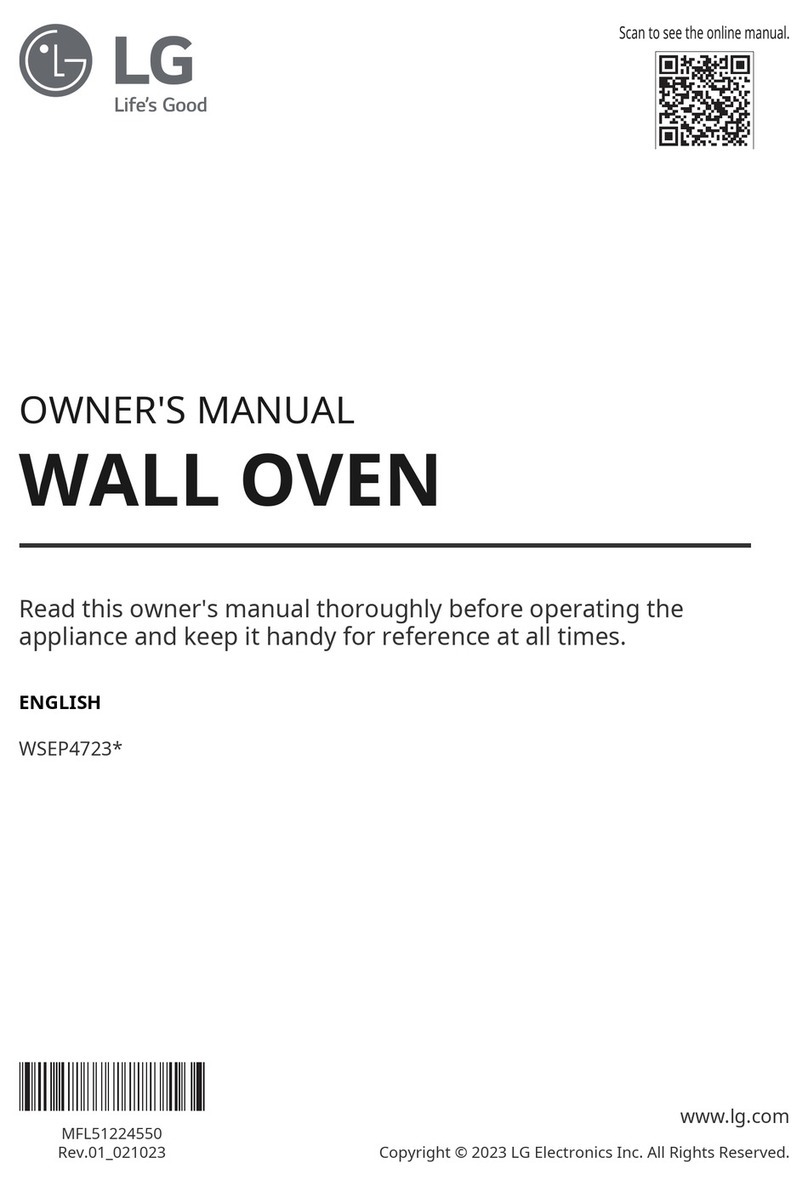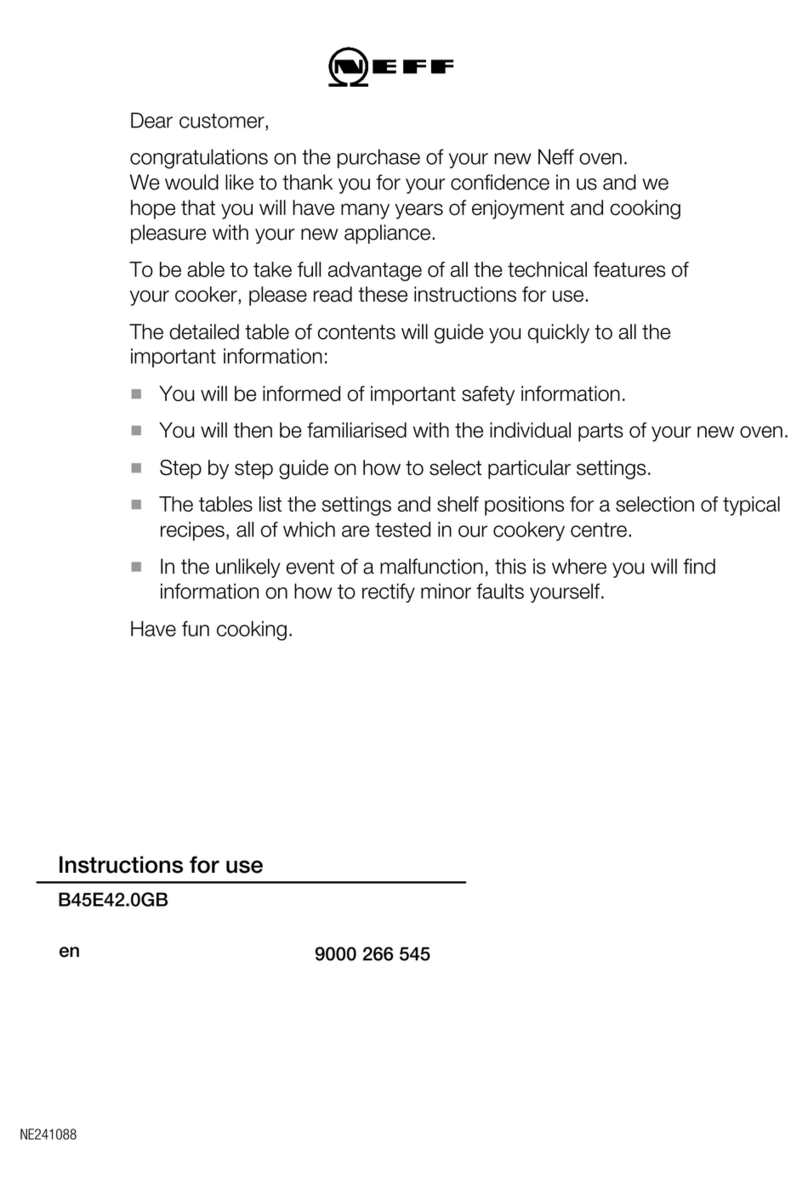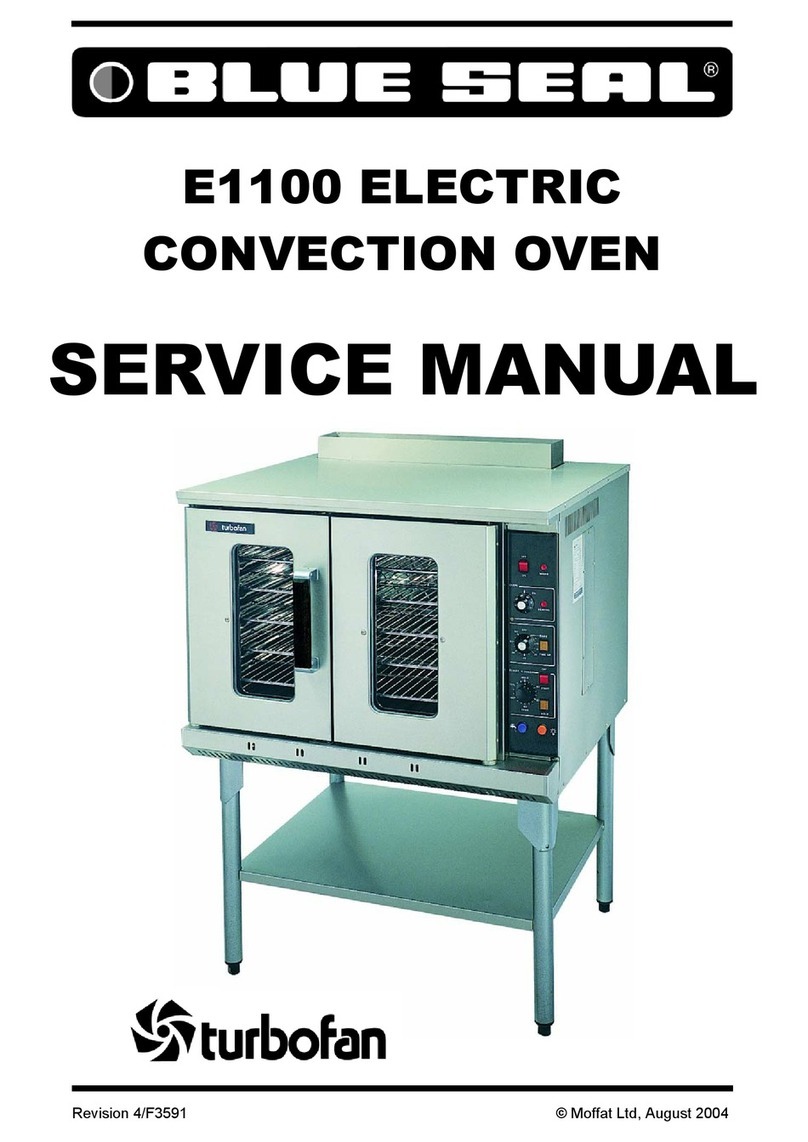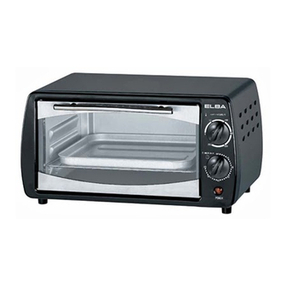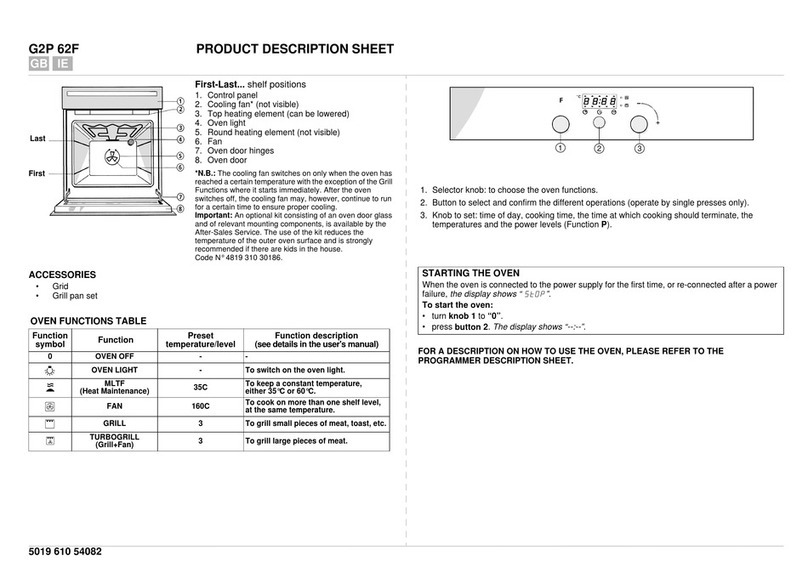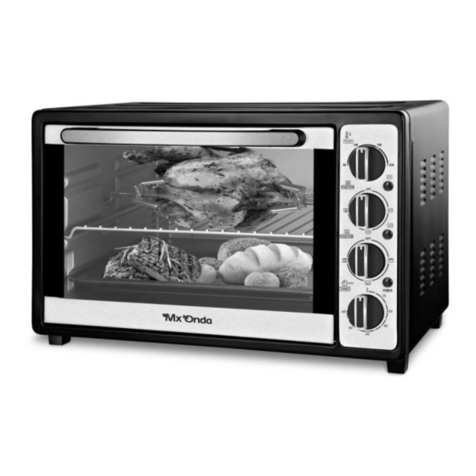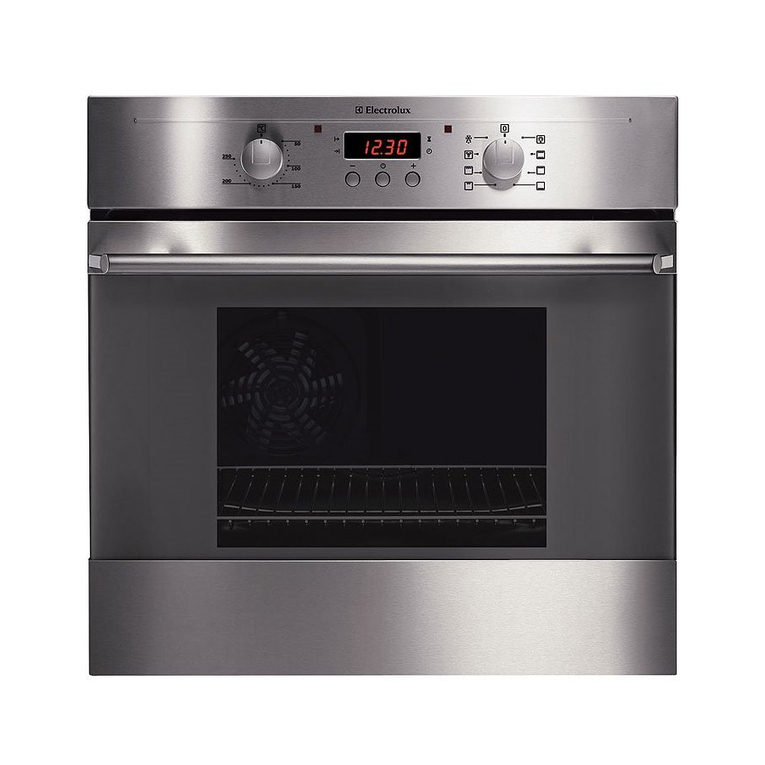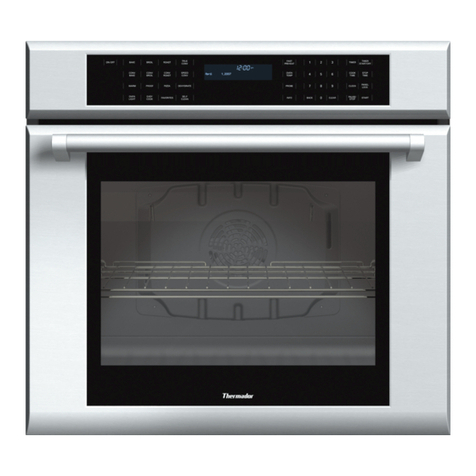Classique CLO64XLSS User manual

User manual for your Classique
600mm Built-in Oven
CLO64XLSS
NOTE: This user manual contains important information including safety & installation
points which will enable you to get the most out of your Classique appliance. Please keep
it in a safe place so that it is readily available for future reference.

Contents
Important safety information 1
Environmental note 3
Installation 4
Using the appliance
Description of the appliance 7
Before first use 9
Selecting an oven function and temperature 10
Cleaning and maintenance 13
Troubleshooting 16
Cooking guidelines 18
Technical information 20

1
Important safety information
Your safety is of the utmost importance. Please make sure that you read this
instruction booklet before attempting to install or use the appliance. If you are
unsure of any of the information contained in this booklet, please contact the
retailer where you purchased your appliance from.
General Information
This appliance is designed for domestic household use and can be built into a standard
kitchen cabinet or housing unit.
The adjacent furniture or housing and all materials used in the installation must be able to
withstand a minimum temperature of 85°C above the ambient temperature of the room it
is located in, whilst in use.
Certain types of vinyl or laminate kitchen furniture are particularly prone to heat damage
or discolouration at temperatures below the guidelines given above.
Any damage caused by the appliance being installed in contravention of this temperature
limit, or by placing adjacent cabinet materials closer than 4mm to the appliance, will be
the liability of the owner.
For use in leisure accommodation vehicles, please refer to the appropriate information
given in the installation instructions for this appliance.
The use of this appliance for any other purpose or in any other environment without the
express agreement of our company will invalidate any warranty or liability claim.
Repairs may only be carried out by an authorised service agent. Log onto
www.classique.co.nz to locate an agent near you.
This appliance complies with all current safety legislation. We do wish to emphasise that
this compliance does not remove the fact that the appliance surfaces will become hot
during use and retain heat after operation.
Child Safety
Classique strongly recommend that babies and young children are prevented from
being near to the appliance and not allowed to touch the appliance at any time.
If it is necessary for younger family members to be in the kitchen, please ensure that they
are kept under close supervision at all times.

2
General Safety
Do not place heavy objects on the oven door or lean on the oven door when it is open,
as this can cause damage to the oven door hinges.
Do not leave heated oil or fat unattended, as this is a fire risk.
Do not place pans or baking trays directly on the base of the oven cavity, or line it with
aluminium foil.
Do not allow electrical fittings or cables to come into contact with areas on the
appliance that get hot.
Do not use the appliance to heat the room it is located in or to dry clothing.
Do not install the appliance next to curtains or soft furnishings.
Do not attempt to lift or move cooking appliances by using the oven door or handle, as
this may cause damage to the appliance or result in injury to the person lifting the
appliance.
Cleaning
Cleaning of the oven should be carried out on a regular basis.
Great care should be taken whilst using this appliance and when following the cleaning
procedure outlined in this user manual. IMPORTANT: The appliance must be
disconnected from the mains before following the cleaning procedure.
Installation
This appliance must be correctly installed by a suitably qualified person,
strictly in accordance with the manufacturer’s instructions.
The manufacturer declines any responsibility for injury or damage, to person or
property, as a result of improper use or installation of this appliance.
Heat, steam and moisture will be created during use of the appliance, take care to avoid
injury and ensure that the room is adequately ventilated. If the appliance is going to be
used for prolonged periods of time, then additional ventilation may be required.
Please consult with your qualified installer if you are in any doubt about the amount of
ventilation that you will require.

3
Environmental note
Note: Before discarding an old appliance, switch off and disconnect it from the power supply. Cut
off and render any plug useless. Cut the cable off directly behind the appliance to prevent misuse.
This should be undertaken by a competent person.
This appliance is marked according to the European directive 2002/96/EC on Waste electrical
and Electronic Equipment (WEEE). By ensuring this product is disposed of correctly, you will
help prevent potential negative consequences for the environment and human health, which
could otherwise be caused by inappropriate waste handling of this product.
The symbol on the product or on the documents accompanying the product indicates that this
appliance may not be treated as household waste. Instead it shall be handed over to the
applicable collection point for the recycling of electrical and electronic equipment.
Disposal must be carried out in accordance with local environmental regulations for waste
disposal. For more detailed information about treatment, recovery and recycling of this product,
please contact your local city office or local waste management office.
The packaging materials that we use are environmentally friendly and can be recycled. Please
discard all packaging material with due regard for the environment.

4
Installation
Electrical connection
WARNING: THIS APPLIANCE MUST BE EARTHED.
This appliance should be wired into a 16 A double pole switched fused spur outlet, having
3 mm contact separation and placed in an easily accessible position adjacent to the
appliance. The spur outlet must still be accessible even when your oven is located in its
housing to enable the appliance to be disconnected from the mains supply.
To connect the oven power cord, loosen and remove the cover on the terminal block, in
order to gain access to the contacts inside. Make the connection, securing the cord in
place with the cable clamp provided and then immediately close the terminal block cover
again.
If you have to change the oven power cord, the earthing (yellow/green) conductor must
always be 10 mm longer than the line conductors.
Care must be taken to ensure that the temperature of the mains supply cable does not
exceed 50°C.
If the mains supply cable is damaged, then it must be replaced by an appropriate
replacement which can be obtained from the Spares Department.

5
Installing the oven into the kitchen cabinet
The kitchen area should be dry and aired and equipped with efficient ventilation.
When installing the oven, easy access to all control elements should be
ensured.
Positioning the appliance
Ensure that the aperture that you will be fitting the oven into is of the size given
in the above diagram.
The oven must be fitted into an oven housing with the ventilation cut-outs
shown in the “Ventilation requirements” section on the next page.
Ensure that the rear panel of the furniture housing unit has been removed.
Ensure that the oven has been securely fixed into the housing unit. The fixing of
the oven into the housing is made by using four screws. These should be
screwed through the oven cabinet and into the housing unit.
Ventilation requirements

6
(Figure shows the ventilation and cut-out requirements for the installation of the
appliance into a standard kitchen unit).
(Figure shows the ventilation and cut-out requirements for the installation of the
appliance into a tall housing unit).
Warning: The appliance must be installed at least 850 mm above the floor.
Ensure that the oven has been securely fixed
into the housing unit. The fixing of the oven
into the housing is made by using four screws.
These should be screwed through the oven
cabinet and into the housing unit.
A
A
A
A

7
Description of the appliance
Control panel
Side shelf Lamp
Oven shelf
Oven door
Door handle
Accessories
Description
Illustration
Qty.
Oven unit
1
Side rack
1 pair
Roasting dish
1
Oven rack
2
Wire insert for
roasting dish
1
Screw and nut
4

8
Control panel
1) Oven function selector knob
2) Power indicator light
3) Mechanical cut off timer
4) Oven operating light
5) Thermostat control knob

9
Before first use
oTo remove any residue from the oven that may have been left from the
manufacturing process, you should select the fan oven function and set the
thermostat to its maximum temperature setting.
oIt is perfectly normal for an odour to be produced during this process.
oYou should make sure that any windows in the room are left open during this
process.
oIt is advisable for you not to remain in the room whilst the burning off process is
taking place.
oYou should leave the oven on maximum setting for 30 –40 minutes.
oAfter the oven cavity has cooled, it should then be cleaned with warm soapy
water, using either a sponge or soft cloth. No abrasive cleaners should be used.
oOuter parts of the oven should be cleaned with warm soapy water, using either a
sponge or soft cloth. No abrasive cleaners should be used.
oWe would recommend that an appropriate stainless steel cleaner and polish is
regularly used on the stainless steel surfaces of this appliance.

10
Selecting an oven function and temperature
Mechanical cut-off timer
To use the oven without using the timer, turn the
Mechanical cut-off timer knob so it is pointing to ON.
You may now proceed to use the oven as normal.
To use the oven with timer, simply turn the
Mechanical cut-off timer knob so that it is pointing to
the desired cooking time (up to 120 minutes) and
proceed to cook as normal. The oven will automatically stop cooking once the
countdown is complete. Be sure to turn the oven function and thermostat control
knob to 0 when cooking is complete.
IMPORTANT: The oven power should be off when the alarm silences. If you
have finished cooking, you should turn the oven function selector and
thermostat control knob to 0.
The oven function selector knob should be used to select the
particular mode of cooking that you require. The appliance
will utilise different elements within the oven cavity,
depending on the oven function that you select. When a
function is selected, the power indicator light will come on.
The oven has 4 functions for your choosing:
OVEN LIGHT: Separate light control which allows the light to be switched on,
even when the oven is not cooking.
DEFROST: This function runs the fan to reduce defrosting time without using
heat. A safe way to gently defrost frozen foods.
FULL GRILL: The grill element at the top of the oven cavity is active.
Ideal for grilling, toasting, or crisping a full shelf of food.
FAN FORCED: Heat from a special element by the fan is evenly distributed
as the fan runs. Handy when cooking on several shelves at once.

11
Thermostat control knob
The oven thermostat control knob sets the required
temperature of the oven. It is possible to regulate the
temperature within a range of 50 - 250°C.
Turn the control knob clockwise.
Oven operating light
This light will come on to indicate that the oven’s heating
elements are in operation. The light will turn off when the
temperature set on the thermostat control knob has been
reached. It will cycle on and off throughout the cooking
time.
You should not place food inside the cavity until the correct cooking
temperature has been reached.
150
250
200
0
100
50
150
250
200
0
100
50

12
Warnings
oKeep the oven door closed when using any of the grill functions.
oDo not use aluminium foil to cover the grill pan or heat items wrapped in
aluminium foil under the grill. The high reflectivity of the foil could potentially
damage the grill element.
oYou should also never line the base of your oven with aluminium foil.
oDuring cooking, never place pans or cookware directly onto the bottom of
your oven. They should always be placed on the shelves provided.
oThe grill heating element and other internal components of the oven become
extremely hot during operation, avoid touching it inadvertently when handling
the food which you are grilling.
oImportant: Be careful when opening the door, to avoid contact with hot parts
of the oven and steam.
oThe drip tray handle should only be used to reposition the drip tray and NOT
for removing it from the oven cavity. When removing the drip tray, you should
ALWAYS use an oven glove.
oThe drip tray handle should not be left in position when the appliance is
switched on.
oA steam cleaner is not to be used.
oWarning: Accessible parts may become hot during use. Young children
should be kept well away when in use.
oDo not use harsh abrasive cleaners or metal scrapers to clean the oven door
glass as this can scratch the surface, which may result in the oven glass
shattering.

13
Cleaning and maintenance
The oven should be cleaned after every use. When cleaning the oven the
lighting should be switched on to enable you to see the surfaces better.
The oven chamber should only be washed with warm water and a small
amount of washing-up liquid.
After cleaning the oven chamber, wipe it dry.
Never clean the oven surfaces by steam cleaning.
The oven cavity should only be cleaned with warm soapy water, using either a
sponge or soft cloth. No abrasive cleaners should be used.
Any stains that may appear on the bottom of the oven will have originated from
food splashes or spilt food, these splashes occur during the cooking process.
These could possibly be a result of the food being cooked at an excessively
high temperature or being placed in cookware that is too small.
You should select a cooking temperature and function that is appropriate for
the food that you are cooking. You should also ensure that the food is placed in
an adequately sized dish and that you use the drip tray where appropriate.
Outer parts of the oven should only be cleaned with warm soapy water, using
either a sponge or soft cloth. No abrasive cleaners should be used.
If you use any form of oven cleaner on your appliance, then you must check
with the manufacturer of the cleaner that it is suitable for use on your
appliance.
Any damage that is caused to the appliance by a cleaning product will not be
fixed free of charge, even if the appliance is within the guarantee period.
Do not use cleaning products containing abrasive materials for the
cleaning and maintenance of the glass front panel.

14
Replacement of the oven light bulb
In order to avoid the possibility of an electric shock ensure that the appliance
is switched off before replacing the bulb.
1. Remove all oven shelves, the drip tray and the side rack that is on the
same side as the oven light.
2. Using a screwdriver, remove the lamp cover.
3. Remove the light bulb and replace it with a halogen lamp.
4. Replace the bulb with another 230V, 25W/ 300°C, cap G9.
5. Do not use any other type of bulb.
6. Place the lamp cover back into position.
7. There is a curve on one side of the lamp cover; this should be on the
right hand side as the cover goes back into place.
Make sure it is properly inserted into the ceramic socket. Do not touch the
light bulb directly with your hands.
Door removal
The hinges (A) have two moveable bolts on them (B). If you raise both of the
moveable bolts (B), then the hinges (A) are released from the oven housing.
Gripping the sides of the door at the centre, incline the door
slightly towards the oven cavity. Pull the door gently
away from the oven cavity.
Make sure that the door is supported at all times and that you place the door
on some padded material whilst cleaning it. The oven door and door glass
should only be cleaned using a damp cloth and a small amount of detergent.
The cloth must not have come into contact with any form of cleaning product
or chemical previously. To refit the door, slide the hinges back into their slots
and open the door fully. The moveable bolts (B) must be closed back into
their original positions before closing the door.
A
B

15
Removal of the internal glass panel
(Your oven comes with a triple glass door)
Press the bracket latch on two sides that is in the corner at the top of the door. Take
out the inner glass from the second blocking mechanism and then take out the
middle glass. After cleaning, insert and block the glass panel, and push the
blocking mechanism.
Regular inspections
Besides keeping the cooker clean, you should:
1. Carry out periodic inspections of the control elements and cooking units
of the cooker.
2. After the guarantee has expired you should have a technical inspection
of the cooker carried out at a service centre at least once every two
years.
3. Fix any operational faults.
4. Carry out periodical maintenance of the cooking units of the cooker.
Caution!
All repairs and regulatory activities should be carried out by the appropriate
service centre or by an appropriately authorised fitter.
Side rack assembly
To assemble the side racks, remove the two frames,
lifting them away from the spacers.
Secure the two frames with the guide rails using the
holes provided on the oven walls.
The holes for the left frame are situated at the top, while
the holes for the right frame are at the bottom.
1
2

16
Troubleshooting
The oven isn’t turning on.
Check that the oven is in manual operation mode.
Check that you have selected a cooking function and a cooking temperature.
There appears to be no power to the oven and grill.
Check that the appliance has been connected to the electrical mains supply
correctly.
Check that the mains fuses are in working order.
Check that the operating instructions for setting the time of day and putting
the appliance into manual operation mode have been followed.
The grill function works but the main oven does not.
Check that you have selected the correct cooking function.
The grill and top oven element is not working, or cuts out for long periods
of time during use.
Allow the oven to cool for approximately 2 hours. Once cool, check whether
the appliance is again working properly.
My food is not cooking properly
Ensure that you are selecting the correct temperature and the correct
cooking function for the food that you are cooking. It may be appropriate to
adjust your cooking temperature by plus or minus 10°C, to achieve the best
cooking results.
My food is not cooking evenly
Check that the oven has been installed correctly and is level.
Check that the correct temperatures and shelf positions are being used.

17
The oven light is not working
Refer to page 14 and follow the “Replacing the oven light bulb” section.
I am getting condensation in my oven.
Steam and condensation is a natural by-product of cooking any food with
high water content, such as frozen food, chicken etc.
You may get condensation in the oven cavity and forming between the oven
door glasses. This is not necessarily a sign that the oven is not working
correctly.
Do not leave food in the oven to cool after it has been cooked and the oven
has been switched off.
Use a covered container, where practical, when cooking to reduce the
amount of condensation that forms.
IMPORTANT: If your appliance appears not to be operating correctly,
please contact the dealer.
DO NOT ATTEMPT TO REPAIR THE APPLIANCE YOURSELF.
Please note that if an engineer is asked to attend whilst the product is under
guarantee and finds that the problem is not the result of an appliance fault, then
you may be liable for the cost of the call out charge.
The appliance must be accessible for the engineer to perform any necessary repair.
If your appliance is installed in such a way that an engineer is concerned that
damage will be caused to the appliance or your kitchen, then they will not complete
a repair.
This includes situations where appliances have been tiled in, sealed in with sealant,
have wooden obstructions placed in front of the appliance such as plinths, or any
installation other than the one specified by our company has been completed.

18
Cooking guidelines
oPlease refer to the information given on food packaging for guidance on
cooking temperatures and times. Once familiar with the performance of your
appliance, temperatures and times can be varied to suit personal preference.
oIf you are using the fan oven function, then you should follow the information
given on the food packaging for this particular mode of cooking.
oMake sure that frozen foods are thoroughly thawed before cooking, unless
the instructions on the food packaging advise that you can “cook from
frozen”.
oYou should pre-heat the oven and not place food inside of it until the oven
operating light has gone off. You can choose not to pre-heat when using the
fan oven mode; however you should extend the cooking time given on the
food packaging by approximately ten minutes.
oBefore cooking, check that any accessories that are not required are
removed from the oven.
oPlace cooking trays in the centre of the oven and leave gaps between the
trays to allow air to circulate.
oTry to open the door as little as possible to view the dishes.
oThe oven light will remain on during cooking.
Table of contents
Other Classique Oven manuals
